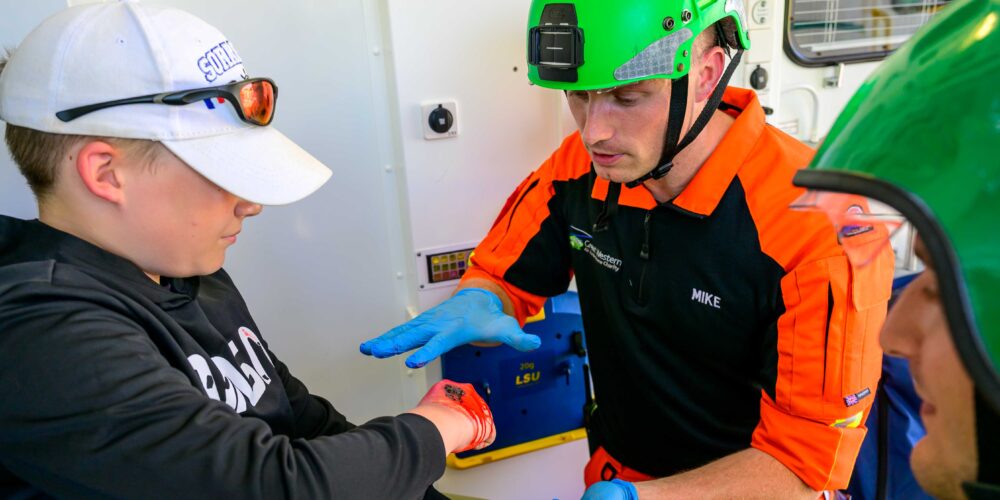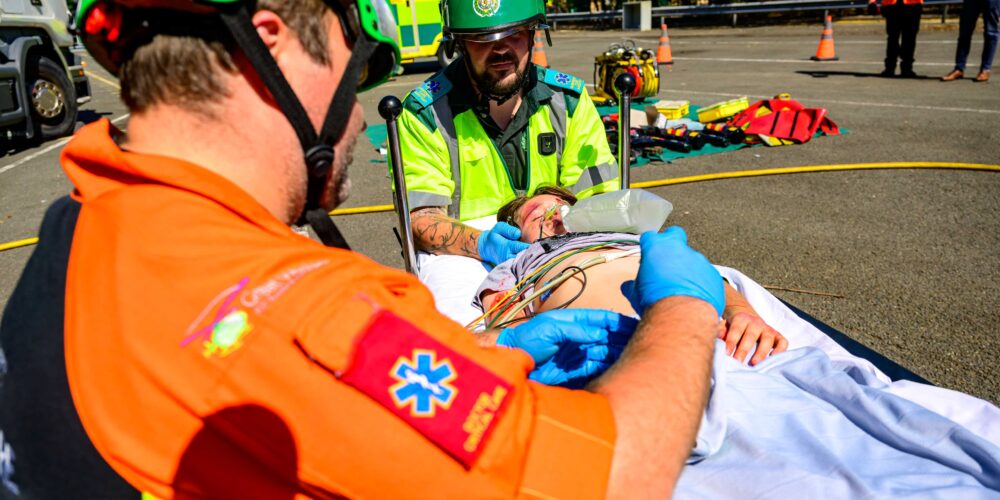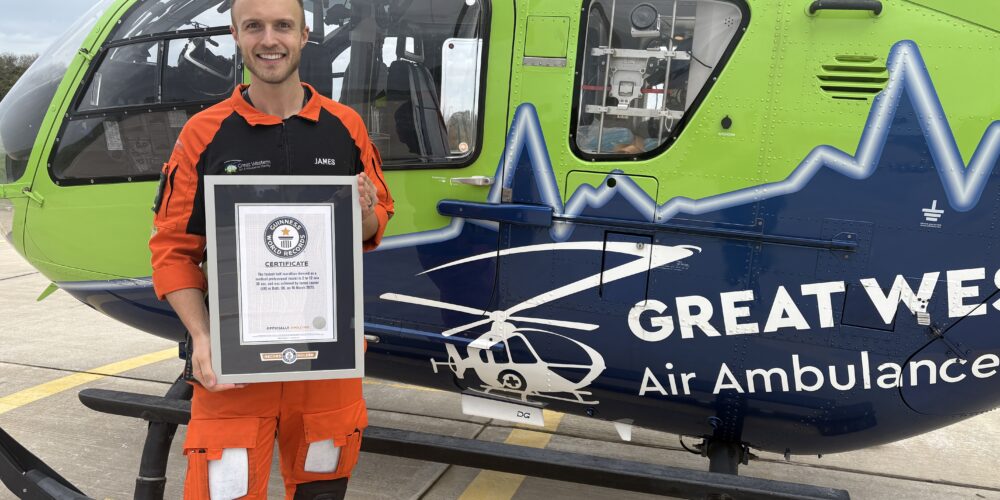
Protecting our Crew’s Welfare
May 7, 2021
Support our COVID-19 Recovery Fund
May 20, 2021Great Western Air Ambulance Charity was founded in 2007. In our first year we ran the service using two cars from a room at the Central Ambulance Station in Bristol. We responded by helicopter for the first time on 3 June 2008. This was an emergency call out to an RTC on the M5.
We started as the only Critical Care Team within the region. Now, attending to an average of over five critically ill or injured patients a day, our crew are one of the busiest Critical Care Teams in the South West, with many other air ambulance charities now following our critical care model.
 What is a Critical Care Team?
What is a Critical Care Team?
Our Critical Care Team consists of a highly trained and experienced Pilot, a Specialist Paramedic in Critical Care and a Critical Care Doctor. Our crew are specialised in Pre-Hospital Emergency Medicine, which means they can perform lifesaving interventions at the scene of an incident. When someone’s life is in danger, every second counts. That’s where we come in.
A Critical Care Team bring the skills found in an emergency hospital to the patient – whether that is giving blood on the side of the road, treating a cardiac arrest in a busy city centre or performing surgery in a field. In instances where the patient may otherwise not make it to hospital, having this level of care on scene can be the difference between life and death.
How we grew to become one of the busiest critical care teams in the region
Over the years our service has grown and changed in a number of ways. However, one thing that has remained the same is our mission – to save lives.
GWAAC’s Air Operations Officer John Wood, who has been with the charity from the very beginning, tells us about some of the key milestones of how our service has grown and improved over the years.
Paying our doctors
When we began, we knew that having doctors onboard meant that we would be able to do much more for our patients. Such as prescribing medication and performing more interventions.
As a charity, we rely on public donations to remain operational. When the charity was first set up, funding was limited so for the first five years of GWAAC being operational we were unable to pay our doctors.
During these years, we were lucky enough to have a bank of doctors that kindly volunteered for GWAAC in their spare time.
All of our doctors are consultants within hospitals, which meant that they were giving up their limited free time to treat more seriously ill and injured patients for free.
Because of our crew’s specialist skills, they attend the most critical incidents across the region. It’s a highly stressful and difficult job. Not being able to pay our doctors for the care and dedication to these patients was disheartening for the charity.
Our clinical and charity team worked hard for many years and in 2011 we were able to take the next big step and start paying our doctors.
John says:
‘’Being able to pay the doctors now really has made a difference. We worked for many years to change that. Once we were able to do this it was a real step forward to professionalizing the team and the unit.’’
Moving from the Bolkow 105 helicopter
To reach those in urgent need quickly, we have a helicopter and two critical care cars. Depending on where the incident is, will determine which mode of transport we use.
For patients further afield and in remote locations, having a helicopter in our fleet is crucial. However, each helicopter is varied and have different capabilities.
John continues:
‘’Another huge step forward for us was changing from our Bolkow 105 helicopter to our Eurocopter EC135. This brought many more advantages for us.’’
Advantages of changing to the new helicopter:
- Four seats instead of three – being able to seat four people within our new helicopter meant that we could now train people live in the air. When we had the Bolkow we could only train people medically from the cars, and meant we couldn’t give them real life experience of being in the helicopter until their first mission.
- Landing on elevated helipads– with the Bolko we weren’t able to land on elevated helipads because of performance issues. This meant that we were unable to land at the BRI and children’s hospital helipads. As a result of this we had to land nearby which was a much more time-consuming way of transporting patients to hospital.
- Greater range – with the EC135 we have a much further range of how far we can go. This gives us more time and flexibility to go from one incident to another without having to refuel first.
- The cab space is 70% bigger – the EC135 had much more space inside than Bolkow. This gave the crew more space to treat patients comfortably in the air.
- Loading patients through the side – with the EC135 we are able to load patients through the side doors instead of the back. It became much easier for the crew to load patients as previously they had very limited space to load them onto the helicopter.


Base move
When the charity first formed, the clinical team were based in a small room in Bristol Ambulance Station. In 2009 they moved their operations to Filton airfield, starting in a small porta cabin but moving to an old hangar on the airfield, Hangar 16m a couple of years later.
Before moving to our purpose built air base in Almondsbury in 2018 our crew spent a number of years operating from Hangar 16m. The Hangar dates back to World War 1 and whilst it was brimming with personality and history, it was quite literally falling apart around them.
John says:
‘’It started to fall down around our ears. One morning we came in and the unsuspended ceiling had fallen down onto the helicopter. Glass roof panels sometimes blew off in the wind and the big steel beam that supported the hangar door fell off one day. It was a health and safety nightmare.’’
During the winter it was absolutely freezing. During the summer, you could hear rats scuttling around in the roof and you certainly couldn’t leave any food out expecting it to still be there in the morning…
As you can see in the images below is was not a good environment for our crew to be working from. In 2018 we launched a Buy our Base capital appeal to raise vital funds to facilitate our move to Almondsbury. Thanks to the support from the public, £1.3million was raised to secure GWAAC’s future.



‘’Moving to our new air base in Almondsbury was a massive step forward. Not only is it better for the crew but it allows us to respond more efficiently. It’s much more of a professional environment which translates to the whole outlook of the unit.’’
There have been many changes since GWAAC began. However, each change has been implemented with one aim in mind – to improve our lifesaving service.
We can only continue to save lives with your support. Find out how you can support GWAAC here: https://greatwesternairambulance.com/how-to-help/



